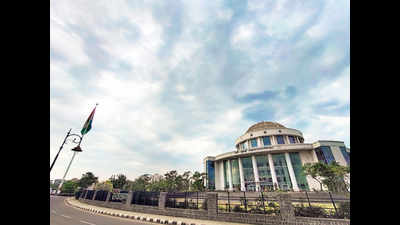- News
- City News
- mumbai News
- In after-effects of Cyclone Nivar, Mumbai’s AQI improves to ‘moderate’
Trending
This story is from November 29, 2020
In after-effects of Cyclone Nivar, Mumbai’s AQI improves to ‘moderate’
After few days of ‘poor’ pollution levels, the city’s air quality index on Saturday improved to moderate due to the after-effects of Cyclone Nivar. System of Air Quality and Weather Forecasting and Research (SAFAR) said the overall AQI for Mumbai was 125.

Every cloud had a silver lining in Navi Mumbai on Saturday
MUMBAI: After few days of ‘poor’ pollution levels, the city’s air quality index on Saturday improved to moderate due to the after-effects of Cyclone Nivar. System of Air Quality and Weather Forecasting and Research (SAFAR) said the overall AQI for Mumbai was 125.
Track the pollution level in your city
An AQI of 101-200 is considered ‘moderate’ and poses minor health issues for sensitive people. The city’s AQI on Friday was 235 (poor).But on Saturday, wind speeds picked up, which disbursed pollutants and cleared the air. “The air quality index will fluctuate for few days. Winds were slow on Friday but due to after-effect of cyclone winds suddenly picked up speed on Saturday,” said SAFAR project director Gufran Beig.
Among 10 locations SAFAR monitored in the city, the most polluted was Mazgaon, with an AQI of 242, and the least polluted was Bhandup, with an AQI of 65. SAFAR has forecast the AQI to marginally improve to 120 on Sunday.
Post-cyclone conditions led to a a cloud cover over most of the state on Saturday, bringing down maximum temperatures. Santacruz and Colaba recorded 33.3 and 31.7 degrees Celsius respectively, lower than 34.2 and 33.8 degrees the previous day. “It is due to post-Nivar effects around the trajectory of the cyclone, where it has pushed lot of moisture, contributing to high clouds that can lower visibility, bring a little drizzle and lower maximum temperatures,” said K S Hosalikar, deputy director-general, western region, IMD.
Track the pollution level in your city
An AQI of 101-200 is considered ‘moderate’ and poses minor health issues for sensitive people. The city’s AQI on Friday was 235 (poor).But on Saturday, wind speeds picked up, which disbursed pollutants and cleared the air. “The air quality index will fluctuate for few days. Winds were slow on Friday but due to after-effect of cyclone winds suddenly picked up speed on Saturday,” said SAFAR project director Gufran Beig.
Among 10 locations SAFAR monitored in the city, the most polluted was Mazgaon, with an AQI of 242, and the least polluted was Bhandup, with an AQI of 65. SAFAR has forecast the AQI to marginally improve to 120 on Sunday.
Aiding better air quality were higher minimum temperatures in the city. Indian Meteorological Department’s Santacruz and Colaba observatories on Saturday recorded a minimum of 23.2 and 24 degrees Celsius respectively. Both were approximately 3 degrees above normal.
Post-cyclone conditions led to a a cloud cover over most of the state on Saturday, bringing down maximum temperatures. Santacruz and Colaba recorded 33.3 and 31.7 degrees Celsius respectively, lower than 34.2 and 33.8 degrees the previous day. “It is due to post-Nivar effects around the trajectory of the cyclone, where it has pushed lot of moisture, contributing to high clouds that can lower visibility, bring a little drizzle and lower maximum temperatures,” said K S Hosalikar, deputy director-general, western region, IMD.
End of Article
FOLLOW US ON SOCIAL MEDIA










